Transaction Monitoring: The Basics
Get informed about transaction monitoring and how it can benefit your business in the fight against financial crime.
In the fight against financial crime, an AML transaction monitoring system is a vital tool. Here's what you need to know about how it works.
What is Transaction Monitoring, and What Does it Do?
Transaction monitoring is the process of flagging activity that appears to be suspicious. This can be done by looking for patterns in customer behavior or by comparing transactions to known red flags for fraud or money laundering.
Money laundering is trying to hide the illicit proceeds of any predicate offense. Fraud is one of these types of predicate offenses. In other words, money laundering is one component of a more significant crime, such as fraud, human trafficking, or narcotics smuggling. The data used to detect fraud overlaps with the data used to detect money laundering.
Transaction monitoring is a necessary part of any anti-money laundering program. By catching suspicious activity early, banks and other financial institutions (FIs) can deter and prevent criminals from accessing the financial system. It can also improve accuracy and security by keeping track of all transactions made in your system. In addition, it can help identify potential problems and resolutions before they cause any significant disruption.
How Can a Transaction Monitoring System Benefit Your Business?
Transaction monitoring and alerting are critical parts of any anti-money laundering program. Transaction monitoring can be used in many ways, including but not limited to the following:
- To detect fraudulent activity: Transaction Monitoring can help you identify money laundering or securities crimes.
- To improve compliance with regulations: Transaction monitoring helps banks and other financial institutions comply with financial sanctions laws and regulations, such as the US Bank Secrecy Act and USA Patriot Act.
- To enrich customer profiles by feeding back to KYC systems: Transaction Monitoring data can be used to update customer profiles by detecting non-declared behavior that could trigger a review or update the customer records.
- To detect inconsistencies in data: Transaction monitoring can help you identify discrepancies between data sources.
Organizations can continuously monitor transactions and alerts to identify anomalous activity indicative of money laundering and fraud. This can be done at the customer, device, and behavior levels. This process can help organizations to respond to potential incidents more quickly and effectively, reducing the impact of financial crime on the organization and subsequent loss of business and reputation.
The Role of AML Transaction Monitoring within FIs
When it comes to transaction monitoring, financial institutions have a responsibility to their customers to take measures to prevent fraud and monitor money laundering activity. This includes implementing policies and procedures designed to identify suspicious activity and training employees to recognize and report potential instances of these financial crimes.
In addition to these internal measures, financial institutions also must report any suspicious transactions to the appropriate authorities. This helps to ensure that law enforcement can investigate potential fraud cases and that victims can get the help they need.
Financial institutions can play a vital role in combating fraud and protecting their customers by taking these steps.
Transaction Monitoring and Alerting Governance
Transaction monitoring and alerting governance are critical for preventing financial crime. By establishing clear guidelines and procedures for transaction monitoring and alerts, organizations can ensure that potentially fraudulent activity is identified and investigated promptly.

Organizations should review their transaction monitoring and alert governance programs regularly to ensure that they effectively detect and prevent fraud and the money laundering associated with it.
Creating the Right Framework
A transaction monitoring and alert management framework should be designed to meet your organization's specific needs. This framework typically sits within the financial crime operations. It should be built following an exhaustive analysis of types of fraud committed against your organization previously and the types of fraud most likely to be attempted in the future.
Your transaction monitoring and alert framework should constantly evolve as new threats emerge and criminals develop new techniques. By staying up to date on the latest fraud prevention strategies, you ensure that your organization is protected against any fraud attempt.
At the same time, any alert management framework should ensure that compliance staff does not suffer from "alert fatigue," meaning a large volume of alerts being processed through repetitive inefficient processes and using legacy systems. This can lead to a lack of attention, motivation, and high staff turnover.
Lastly, the framework should also have a balanced approach toward elements like risk & controls, regulatory compliance, and customer friction. In other words: we need to remain compliant while having a good set of controls that will ensure the institution is protected and customers can operate and transact smoothly.
Lucinity AML Solutions Improve Transaction Monitoring
Lucinity has teamed up with SEON, a fraud management solutions company, to include real-time fraud prevention capabilities in its AML compliance software. This way, Lucinity empowers AML analysts with machine learning algorithms to analyze real-time transactions and flag suspicious activity for further review. Through this partnership, Lucinity users have access to a comprehensive view of all transactions, helping businesses enact a risk-based solution to detect and prevent fraud before it occurs.
Fraud is an increasingly common problem, significantly damaging with the current economic downturn. Lucinity and its partners have built a valuable platform that enables businesses to remain compliant, protect themselves from financial crime losses and keep their customers safe and transacting smoothly.
Conclusion
As the fight against financial crime intensifies, so does the need for sophisticated monitoring tools. Coupled with implementing higher transaction monitoring standards, financial institutions must become more data-driven and proactive in combating financial crime.
However, there's growing recognition that transaction monitoring is only part of the picture. A more holistic, integrated approach that monitors and flags anomalies across the customer journey is needed. That's precisely the balanced approach Lucinity is taking in its strategy.
Learn more about Lucinity's Transaction Monitoring Solution:





